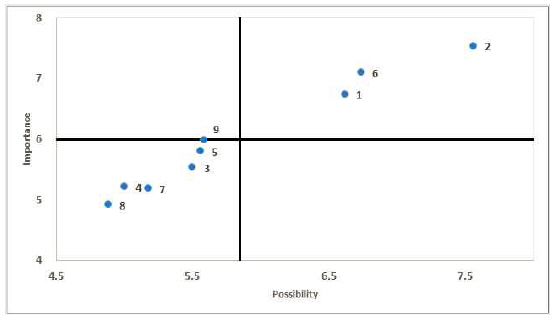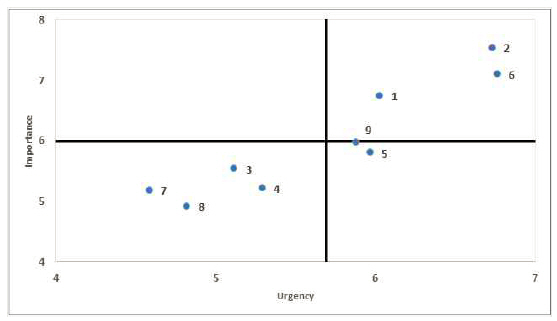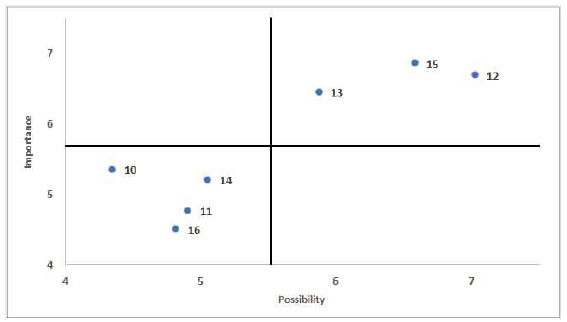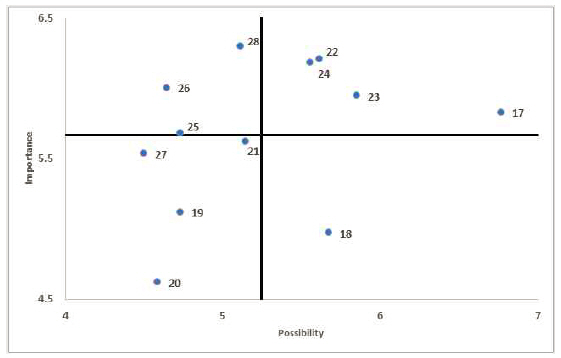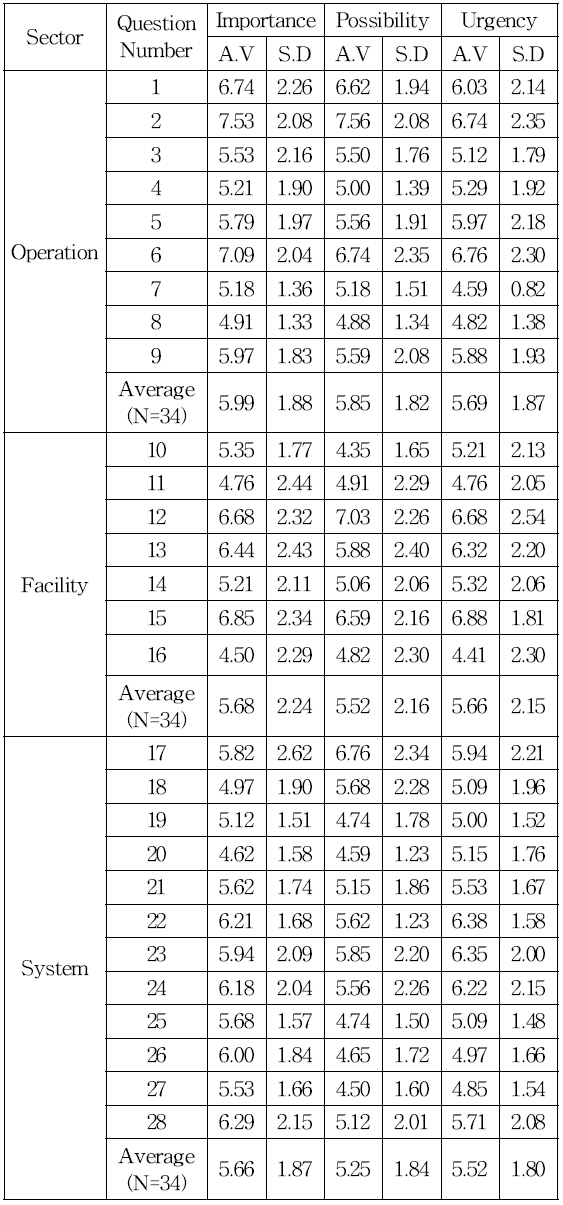A Study on the Operation System Improvement of Busan International Passenger Terminal: Focusing on the Car Ferry
Article information
Abstract
In the past 20 years, passenger and cargo transportation performance at the international passenger ports in Korea have increased by 8.6% on the compound annual growth rate, respectively. The Korean government had expected to continue expanding the market of car ferries and the government included plans for the development of additional routes and lanes with neighboring countries such as China, Japan, and Russia as a part of the Plan of the Korean Ministry of Oceans and Fisheries in 2019. However, compared to the development of routes, the management and operation of passenger terminals are inefficient. The purpose of this paper was to introduce the overall improvement of the passenger terminal operating system that reflects the recent changes in the supply and demand of international passenger vessels and the needs of the government and private sector passengers. To this end, a basic survey was conducted on the status of operations and facilities at the Busan International Passenger Terminal and a questionnaire survey was administered on the subject of use. The results of the survey were analyzed using the IPA model. As a result of the analysis, three items in the operation sector, three items in the facility sector, and four items in the system sector of the Busan International Passenger Terminal were identified as in need of improvement. Based on the results, the need for investment to improve the international passenger terminal operating system is suggested.
1. Introduction
In 1970, the first car ferry in Korea had begun to operate international service with Japan and the first car ferry between Korea and China started to operating its service in 1990. The car ferry market in Korea has been growing fast and stable since the number of car ferry routes increased from 11 to 21 from 1998 to 2019. The compound annual growth rate of passenger and cargo during the last 20 years in Korea is 8.6 percentage, respectively(MOF, 2019). Also, according to the 「Plan of Korean Ministry of Oceans and Fisheries(hereafter MOF) in 2019」, the promotion of new routes such as Korea-China and Korea-Japan-Russia was appointed one of the main issues; therefore, it is expected to expend the route and frequency of car ferry services in Korea(MOF, 2019).
As such, it is expected that the demand for car ferry services and market size will continue to increase, but the most infrastructure of international passenger terminals in Korea remain at a level similar to the beginning of the operation of car ferry service. In other words, the need for improvement of the convenience for passengers using international passenger terminals and the inefficiencies of cargo handling facilities, operation, and management, have emerged as compared to the active development of the car ferry routes. The MOF has been sequentially developing terminals and berths around major passenger terminals to provide smooth passage conditions for vessels several years ago.
However, demand for improvement is expected to continue in the future, such as the development of additional berths which are unresolved issues, expansion of terminal convenience facilities, the efficiency of customs clearance, enhancement of convenience for passenger transportation infrastructure, and development of advanced service for international passenger terminals. In fact, in recent years, there has been a strong demand for improvement of facilities, operations, and related systems centering on major international passenger terminals in Korea. In particular, the international passenger terminal at Busan Port is looking for ways to improve terminal facilities and create added value in preparation for increased passenger demand(MOF, 2019).
As a result of the recent changes in the supply and demand of international passenger ships, the Busan International Passenger Terminal faces demands for improvement in various aspects such as facilities, operations, and regulations. Furthermore, with the emergence of lower cost carrier(LCC) going to and from Korea and Japan, it is challenged not only to secure the competitiveness of cargo transportation but also to introduce high-speed vessels. Therefore, it is urgent to prepare a plan to improve the effective and differentiated international passenger terminal operating system considering the mid- and long-term supply and demand changes in the market of international passenger transportation at Busan Port.
Under this consciousness of the problem, this study conducted a basic survey on the status of operations and facilities for the international passenger terminal at Busan Port and conducted a questionnaire survey on subjects using international passenger terminals to improve the overall operating system of passenger ports. To provide stable domestic supply and demand for passengers and cargoes in the event of a full-fledged increase in the international passenger port, the necessity to improve the facilities and operating system of each berth in Busan Port and to provide comments for policymakers are proposed.
2. Literature Review
To improve the operating system of the international passenger terminal, we reviewed previous research on a car ferry, and within the context, we intend to present the distinction of this study.
In the MOF(2000) report, the environmental changes in the international marine passenger market of Northeast Asia, and the status and problems of the international passenger terminal in Korea were reviewed. Facilities and functions, capacity limitations, and the governance of international passenger terminal were identified as major issues. As a result of the study, Port Passenger Terminal Corporation(tentative title) was introduced as a plan to establish an efficient and advanced management operating system for an international passenger terminal.
KMI(2007) presented standard guidelines for the economic feasibility assessment method of international passenger terminals and marina facilities. The difference from the existing related studies is that it presents an objective measure of benefits and devises a useful method of measuring benefits. In particular, it measured not only the value of use but also the value of non-use as an economic benefit item. It was confirmed that both after-value and pre-value evaluation are possible, and it was proposed to apply Contingent Valuation Method (hereafter CVM).
Lee(2007) derived potential and problems as a hub for logistics and car ferry in Northeast Asia through SWOT analysis for Sokcho Port in Korea. A strategic plan of infrastructure development for Sokcho Port was proposed to be a hub for logistics and car ferry in Northeast Asia. Kim et al.(2007) identified the causes of cargo concentration in car ferry companies rather than containers despite high fare on the Korea-Japan route. As a result, the authors argued that the car ferry gains competitiveness through promptness and accuracy. This competitiveness is not only an advanced method of logistics but also the creation of a mode of daily connection with a single economic zone which is called stockless logistics between Korea and Japan.
In the MOL(2012) report, the performance of the Korea-China shipping cooperation was evaluated. The countermeasures of the liner and car ferry market according to changes in the shipping logistics environment and the development plan of shipping cooperation between the two countries were suggested. To this end, the status of the ocean shipping routes, shipping companies, and cargo volume between Korea and China were analyzed. The expert interviews were conducted with the car ferry companies and related associations. As a result, it is necessary to find a way to increase the cargo volume of the Korea-China route. Efforts to resolve the excess of bottoms, profitability improvement of the shipping company, pursuance of a strategy to diversify and upgrade the service for the car ferry, service quality improvement of the passenger terminal, expansion of multimodal transportation system, and some other comments for policymakers were suggested.
KMI(2012) suggested a plan to promote stable management of car ferry companies in Korea and China according to internal and external environmental changes in Pyeongtaek Port. In particular, the urgent need to adjust the imbalance between supply and demand structure of the routes between Korea and China and to activate the car ferry route was suggested. It was analyzed that the car ferry routes have differentiated characteristics, but it has a low level of speed and convenience, which acts as a barrier to route activation. Therefore, as a way to develop the car ferry route, in terms of infrastructure, to enhance accessibility and efficiency through the expansion of facilities, to strengthen the inter-operating system between industries to enhance the speed of operating system, to establish a consortium between Korea and China, and to focus on passengers for convenience in service system provision and RFID-based electronic payment method linkage were presented.
Park(2013) identified the characteristics of the cargo transportation of the car ferry and analyzed the container traffic volume of the Korea-China car ferry route to confirm the contribution to port performance. Besides, a survey was conducted on car ferry companies, container shipping companies, and forwarders to suggest ways to improve the competitiveness of car ferry companies. Lee et al.(2013) evaluated the efficiency level of the Korea-China car ferry route by using the DEA model. As a result, the Incheon-Yingkou, Incheon-Lianyungang, and Pyeong Taek-Lianyungang routes were evaluated as high-efficiency routes. In terms of passenger efficiency, Incheon-Dalian, Incheon-Dandong, PyeongTaek-Weihai, Gunsan-Shidao routes were high.
Jung and Yeo(2014) tried to strengthen competitiveness by presenting the importance of service factors of Korean and Chinese car ferry companies. Cooperation between customs clearance and trailer inter-running should be done promptly for the rapid transportation of cargo. Oh and Koo (2015) researched and analyzed the policy demands of the international car ferry market, focusing on the Korea-Japan route and the Korea-China route to provide recommendations for car ferry companies and policymakers. The study found that the most important issue was safety and the most significant factor wat securing the operational safety of the car ferry company.
In the KMI(2018) report, the analysis of the impact of opening the Korea-China car ferry route was pointed out at the Korea-China Shipping Talks in 2017. It was also suggested to open the Korea-China shipping market and to direct the development of the shipping liner industry in both countries. As a result, the necessity of a policy to promote competition of the shipping liner and car ferry market was suggested. Lee and Kim(2018) used hierarchical analysis to derive strategic priorities for the growth and development of the shipping and logistics industry. As a result of the analysis, secured e-commerce volume, policy and financial support, the safety of ship operation, diversification of freight rates, and governance should be considered first.
As a result of previous studies related to the car ferry, many studies were focused on the car ferry route in Korea and China with a large volume of traffic occupied a significant number. However, there were no studies based on quantitative analysis for policymakers. This study focuses on the car ferry route of Busan Port and conducts questionnaire surveys to experts, actual customers. It is also trying to resolve the issues that require urgent policy support by using the Importance-Performance Analysis (hereafter IPA).
3. Data and Method
3.1 Data
The purpose of this survey is to collect the perceptions of users on the improvement of the Busan International Passenger Terminal operating system in a numerical form applicable to the IPA model. The scope of the subject of use was limited to selected experts working at the terminal operation companies and cargo handling companies of the Busan International Passenger Terminal. Also, experts working at car ferry companies and public organizations such as MOF, port authority, and local government. The questionnaire distributed to experts is classified into three attributes: importance, possibility, and urgency. It consists of several detailed items belonging to each attribute. The questionnaire items were firstly identified through recent press releases related to international passenger terminals and external publications such as newspaper articles. Based on this, two preliminary field surveys of experts were conducted before the full-scale execution of this study. The final selected questionnaire consists of three main categories: the operating system, facilities, and internal and external systems of international passenger terminals. The detailed items are composed of contents that meet the purpose of this study among the issues presented by terminal users in the preliminary survey.
The full-scale survey was conducted by visiting the institution in person for about two months from July to September in 2019 and receiving answers on the same day. In the case of existing studies, it is common to collect the questionnaire in the same way after distributing it using e-mail, mail, fax, etc. A total of 35 copies of the questionnaire were collected, and 34 copies of the questionnaire, except one which was unsuitable for research purposes, were finally used for analysis. The demographic characteristics of the survey subjects are shown in Table 1 below.
3.2 Method
In this study, the IPA technique was applied and it is based on survey data for experts. The IPA analysis was devised by Martilla and James(1977), and the importance and performance of each evaluation element were measured and displayed on the drawing. The quadrant separated in the drawing is IP (Importance-Performance). This technique is mainly applied not only in the marketing field but also in the fields of education, sports, psychology, tourism, industrial competitiveness, and service evaluation. Using the expectations of related consumers, the future direction is presented as an analysis result(Kim and Hyun, 2018).
IPA techniques traditionally compare and evaluate the association between the importance and achievement of key attributes for analytical objects(Martilla and James, 1977). Here, the importance and achievement that are the basis of the analysis are based on the subject's perception of the analysis object. Therefore, for the IPA, first, the attributes and factors of the analysis target are determined, and then the data are collected through questionnaires of survey respondents about the importance and achievement. When creating a matrix, the average value or median value for each attribute is displayed as dots on the matrix, with the importance as the Y-axis and the achievement as the X-axis.
However, in this study, a matrix was created with the importance of the Y-axis, the possibility and urgency as the X-axis, in order to meet the purpose of the survey. The necessity to introduce detailed information related to future operations, facilities, and systems for the Busan International Passenger Terminal can be found. Similar to the traditional IPA technique, quadrants plotted on the X-Y axis have different meanings for each domain(Lim et al., 2017). For instance, the sustained area in the quadrant is an area with high importance, possibility, and urgency. When interpreting it, the items belonging to the first quadrant are the most important, possible, and urgent parts compared to other items. It can be judged that the need for this item is the highest. The quadrant III, which is symmetric with the first quadrant, is a progressive area of improvement, and the items belonging to this area are low in importance, possibility, and urgency.
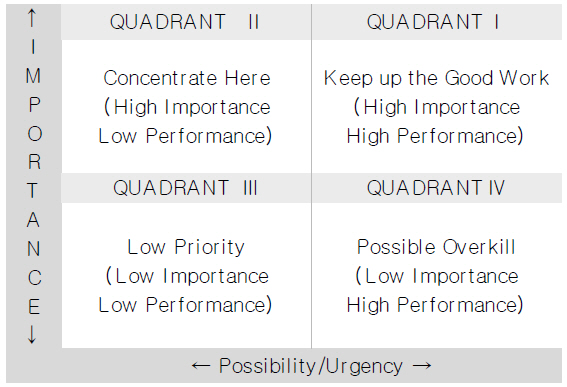
Importance-Performance Analysis grid
Source : Raymond and ChuTat(2000)
Unlike traditional IPA analysis, which is limited to the achievement or satisfaction of policy and system, recent research has tried to set various criteria such as possibility and urgency and to derive common analysis results. For example, according to the KMI(2019) report, in the process of analyzing individual sectors require the introduction of blockchain technology into the fisheries sector in the future. Two matrices consisting of importance-possibility and importance-urgency were established. Also, through common analysis results derived from each matrix, detailed items that require the introduction of blockchain technology in the field of fisheries-related policies and institutions, and in the field of fishery products have been presented. This IPA application technique has the advantage of providing more reliable results by matrix the interrelationships between standards and deriving common items belonging to each standard.
In this study, it is significant that the advantages of the applied technique of IPA and the visualization of traditional IPA were used to further subdivide into the operation, facilities, and internal and external systems for Busan Port. This segmentation in this study has the following advantages in the process of deriving the analysis results. In particular, IPA has the advantage of being able to easily identify the priorities of individual and common policies and systems. Therefore, the application of this IPA analysis method is useful mainly due to efficiently propose a direction for the research topic of policy. A policy considering the specificity and priority of the analysis target can be presented in the field of policy research.
4. Empirical Analysis
In this study, for the empirical analysis, the requirements of the Busan International Passenger Terminal's operation, facilities, and internal and external systems need to be improved in these days. The survey method is first analyzed through daily newspapers and government department press releases. Also, in-depth expert interviews were conducted by visiting the Busan Regional Office of MOF, Busan Port Authority, car ferry companies and related organizations, terminal operators, and logistics companies. In-depth expert interviews have the advantage of being able to substantially identify unpublished problems and demand for improvement on key issues.
Most of the issues in the operation section of Busan Port were focused on improving the current operating system to maximize passenger traffic. The main issues are the provision of terminal subsidiary facilities to revitalize the operation of passenger terminals and the intention to use passengers, establishing an integrated ticketing system to improve the convenience of passengers entering and leaving the country, and the transportation infrastructure to enhance passenger accessibility. Also, there were other issues differentiated from passenger terminals on the West Coast of Korea, such as the construction of a regular inspection manual to prevent accidents on boarding bridges. In the facility sector, it was composed of issues to expand cargo volume and increase the number of ships. In particular, it is possible to commercialize the berth through the renovation which is operated in a dedicated form. This renovation can be able to increase the availability of the current cargo conveyor belt and to safely operate mobile loading and unloading equipment in the yard. It is mainly focused on preparing for an increase in cargo volume, such as reorganizing road facilities and setting up individual storage space for chassis. The issues of the system also include the need to establish consultation channels between the government, car ferry companies, and cargo handling companies, and the need for government support to expand the integrated truck transportation system. Based on these issues, the final questionnaire is developed and divided into 3 sectors with a total of 28 questions as shown in Table 2.
4.1 Descriptive statistics of variables
Among the items constituting the operation section of Busan Port, the number of items exceeding the overall average for each attribute was in the order of 5 urgencies, 3 importance, and 3 possibilities. In the case of the item with the highest average value, the importance is the establishment of safety manual (No. 2), the probability is also the establishment of safety manual (No. 2), and the urgency is the expansion of passenger transport infrastructure convenience (No. 6). In other words, it can be seen that experts’ perception of the area of improvement in the operation sector differed according to each attribute.
Among the items constituting the facility sector, the number of items that exceeded the overall average for each attribute was 3 in order of importance, 3 possibilities, and 3 urgency. In the case of an item with the highest average, the importance is the increased passenger convenience facilities (No. 15), the possibility is the repairs of the road in the yard (No. 12), and the urgent need is the increased passenger convenience facilities (No. 15). However, among the total of 9 items, 3 items that showed a common higher level than the average were found in all 3 attributes such as the importance, possibility, and urgency of improvement. The relevant items are identified as repairs of the road in the yard (No. 12), setting additional chassis space (No. 13), and increase passenger convenience facilities (No. 15). In particular, for each attribute, in the case of importance, increase passenger convenience facilities (No. 15), the repairs of the road in the yard (No. 12), and the urgency of increase passenger convenience facilities (No. 15) are the highest. In other words, it can be seen that experts' perception of the area of improvement in the facility sector differed according to each attribute.
Among the items in the institutional sector, the number of items that exceeded the overall average for each attribute was found in the order of 7 importance, 6 urgency, and 5 possibility. In the case of the item with the highest average value, the importance is supporting complex trucking system (No. 28), the possibility is the selective application of facility fees (No. 17), and the urgency is establishing a clear standard for the official cost (No. 22). On the other hand, out of the 12 items, 4 items showed a common higher level than the average in all 3 attributes, such as the importance, possibility, and urgency of improvement. The relevant items are selective application of facility fees (No. 17), establishing a clear standard for the official cost (No. 22), enforcement of official cost item increase limit policy (No. 23), and government’s incentive policy to activate passenger ports (No. 24). In particular, in the case of importance for each attribute, supporting Complex trucking system (No. 28), the possibility of selective application of facility fees (No. 17), and the urgency of establishing a clear standard for the official cost (No. 22) are recorded the highest average value. In other words, it can be seen that experts' perception of the area of improvement in the system sector differed according to each attribute.
4.2 Result
Most of the items belonging to ‘Priority-Possibility’ and ‘Priority-Urgentness’ were derived similarly. In the first quadrant, measures to enhance passenger's use of terminal facilities and services(No.1), the establishment of safety manual(No.2), and expansion of passenger transport infrastructure convenience(No.6) are located. These three items are important, possible, and urgent. In the third quadrant, restrictions on movement of the lower passenger gate of the unloading device(No.3), reorganization of the rules of operation related to the processing of cargo in Yard(No.4), operation of a big data analysis system(No.7), and management and operation of the terminal based on RFID system(No.8) are located. The importance, possibility, and urgency of these four items are low. In the case of the establishment of an integrated ticket system(No.5) is highly important and possible, but the urgency is low.; therefore, excessive improvement efforts should be avoided.
As a result of the IPA analysis of the facility sector in Busan Port, the items of ‘Priority-Possibility’ and ‘Priority- Urgentness’ were derived similarly. Items in the first quadrant are repairs of the road in the yard(No.12), setting additional chassis space(No.13), and increase passenger convenience facilities(No.15). All three items are important, possible, and urgent. Details of the third quadrants, increased availability of cargo conveyor belts(No.10), standardization of car ferry berth(No.11), efficient passenger baggage handling system(No.14), and installation of protection facilities(No.16) are not important, possible, and urgent.
As a result of the IPA analysis of the system sector in Busan Port, the items of ‘Priority-Possibility’ and ‘Priority-Urgentness’ were derived similarly. Selective application of facility fees(No.17) and establishing a clear standard for the official cost(No.22), enforcement of official cost item increase limit policy(No.23), government’s incentive policy to activate passenger ports(No.24) are important, possible, and urgent. They need to be maintained continuously in the future due to its high possible and urgent nature. The custom single window project(No.26), which belongs to the second quadrant is an item of low importance, possibility, and urgency. Reflection a 4th port plan for expansion of car ferry berth(No.19), additional law and system for safe berth(No.20) and integrated logistics system project(No.27) have both low importance and possibility; therefore, it is considered unnecessary to concentrate excessively to improve the passenger port operating system. The discussion among government, shipping company and loading company for public berth(No.18) related to the privatization work, which belongs to the fourth(possibility) and third(urgency) quadrant, has high possibility but low importance. Therefore, it is analyzed that excessive improvement efforts should be avoided.
5. Conclusion
The purpose of this study is to investigate the issues and directions for improvement in the overall management system, including the management and operation, facilities, and internal and external systems of the Busan International Passenger Terminal. This study also presents implications through the IPA. The survey was conducted by a total of 34 experts working at marine passenger terminal operators, cargo handling companies, shipping companies, and facility management centers. We distributed questionnaires with our visits and immediately received answers at the site. Analyzing the issues related to the improvement of the service quality of the Busan International Passenger Terminal, three items were selected in each sector. The results of this study are summarized as follows.
First, in the operation sector, the 'expansion of passenger transport infrastructure convenience' was selected as the main improvement item. It is noteworthy that the need to improve the accessibility of passengers in Busan Port, where the new international passenger terminal is open. Therefore, the operator of the passenger port should proactively prepare a policy guideline for expanding the transportation infrastructure in consultation with the local government to improve the convenience and utilization of passenger access to the new international terminal. In particular, in the case of Busan Port, the public transportation accessibility such as subway and taxi to the new international passenger terminal is not in good shape, Also, there are only two buses(# 5-1 and 1004) available. Therefore, passenger convenience is low compared to Incheon and Pyeongtaek Port which are the similar size of ports in Korea. This is considered to be a high demand for improvement of transportation facilities and customs clearance systems, which are directly related to the importance of revitalizing passenger use in terms of importance, possibility, and urgency of improvement projects.
Second, in the facility sector, ‘setting additional chassis space’ and ‘increase passenger convenience facilities’ are likely to be improved and urgently needed to be resolved. Particularly, considering that ‘setting additional chassis space’ is selected as a major improvement in Busan Port, which has high cargo incidence. Improvement work such as rearrangement of cargo storage space in the yard is considered an urgent issue. In the case of the Busan New International Passenger Terminal, the chassis storage space is narrow and scattered in the yard. This can be a major factor in the occurrence of safety accidents and deterioration of logistics efficiency; therefore, urgent improvement is necessary. Also, the ‘increase in passenger convenience facilities item’ is selected. The majority of experts evaluated the narrow passenger waiting facilities and the absence of amusement facilities as a competitive advantage compared to the airport's advanced facilities. This suggests the necessity of establishing a clear direction for improvement by selectively considering the convenience of passengers and the efficiency of logistics at the operator level for the port. As a result, there is a high demand for a clear setting of the yard chassis storage space for passenger convenience and cargo efficiency.
Third, in the system sector, issues related to monetary support and cost reduction are selected as major items that can be improved and urgently needed. In particular, all experts point out the improvement of ‘the government’s incentive policy to activate passenger ports’ as the top priority. The majority of experts seem to be focusing on monetary support for improving passenger and cargo service quality, The ‘enforcement of official cost item increase limit policy’ is also selected. It is selected as an urgent item to improve ‘establishing a clear standard for the official cost.’ In particular, the cost of operating the terminal facilities is related to maintenance, repair, and improvement. This means that many stakeholders have different opinions and points of view. Therefore, it would be difficult to agree on solving monetary issues among the stakeholders. As a result, the system should consider the burden of cost among operator, contractor, and shipper and should need to set the official cost.
Recently, the competition in the car ferry market has become actual mainly due to the full-fledged operation of low-cost airlines. There is also a possibility of cargo departure from a full container ship. The overall operating system of international passenger ports is smaller than international airports but the capability of car ferry is larger than aircraft. Also, the economic effect of creating a value-added industry related to car ferry passengers, which is visited by approximately 1.5 million people in Korea, is not negligible. Therefore, it can be said that the government needs continuous attention and support for the operation of passenger terminals, facilities, and systems based on long-term perspectives. Above all, it seems that investment is needed to improve the operating system of the international passenger terminal. Then, passengers can get on- and off-board comfortably and find a terminal to enjoy the value-added industry.
Acknowledgements
This study is a part of the research "A Study on Improvements to the Operation of International Passenger Ports in Korea: Focusing on operation, facility and system", which was published by Korea Maritime Institute in 2019.



